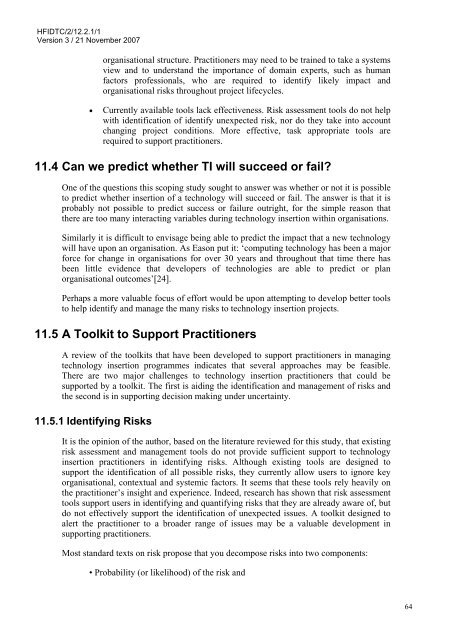The Impact of Technology Insertion on Organisations
The Impact of Technology Insertion on Organisations
The Impact of Technology Insertion on Organisations
You also want an ePaper? Increase the reach of your titles
YUMPU automatically turns print PDFs into web optimized ePapers that Google loves.
HFIDTC/2/12.2.1/1<br />
Versi<strong>on</strong> 3 / 21 November 2007<br />
organisati<strong>on</strong>al structure. Practiti<strong>on</strong>ers may need to be trained to take a systems<br />
view and to understand the importance <str<strong>on</strong>g>of</str<strong>on</strong>g> domain experts, such as human<br />
factors pr<str<strong>on</strong>g>of</str<strong>on</strong>g>essi<strong>on</strong>als, who are required to identify likely impact and<br />
organisati<strong>on</strong>al risks throughout project lifecycles.<br />
• Currently available tools lack effectiveness. Risk assessment tools do not help<br />
with identificati<strong>on</strong> <str<strong>on</strong>g>of</str<strong>on</strong>g> identify unexpected risk, nor do they take into account<br />
changing project c<strong>on</strong>diti<strong>on</strong>s. More effective, task appropriate tools are<br />
required to support practiti<strong>on</strong>ers.<br />
11.4 Can we predict whether TI will succeed or fail?<br />
One <str<strong>on</strong>g>of</str<strong>on</strong>g> the questi<strong>on</strong>s this scoping study sought to answer was whether or not it is possible<br />
to predict whether inserti<strong>on</strong> <str<strong>on</strong>g>of</str<strong>on</strong>g> a technology will succeed or fail. <str<strong>on</strong>g>The</str<strong>on</strong>g> answer is that it is<br />
probably not possible to predict success or failure outright, for the simple reas<strong>on</strong> that<br />
there are too many interacting variables during technology inserti<strong>on</strong> within organisati<strong>on</strong>s.<br />
Similarly it is difficult to envisage being able to predict the impact that a new technology<br />
will have up<strong>on</strong> an organisati<strong>on</strong>. As Eas<strong>on</strong> put it: ‘computing technology has been a major<br />
force for change in organisati<strong>on</strong>s for over 30 years and throughout that time there has<br />
been little evidence that developers <str<strong>on</strong>g>of</str<strong>on</strong>g> technologies are able to predict or plan<br />
organisati<strong>on</strong>al outcomes’ [24].<br />
Perhaps a more valuable focus <str<strong>on</strong>g>of</str<strong>on</strong>g> effort would be up<strong>on</strong> attempting to develop better tools<br />
to help identify and manage the many risks to technology inserti<strong>on</strong> projects.<br />
11.5 A Toolkit to Support Practiti<strong>on</strong>ers<br />
A review <str<strong>on</strong>g>of</str<strong>on</strong>g> the toolkits that have been developed to support practiti<strong>on</strong>ers in managing<br />
technology inserti<strong>on</strong> programmes indicates that several approaches may be feasible.<br />
<str<strong>on</strong>g>The</str<strong>on</strong>g>re are two major challenges to technology inserti<strong>on</strong> practiti<strong>on</strong>ers that could be<br />
supported by a toolkit. <str<strong>on</strong>g>The</str<strong>on</strong>g> first is aiding the identificati<strong>on</strong> and management <str<strong>on</strong>g>of</str<strong>on</strong>g> risks and<br />
the sec<strong>on</strong>d is in supporting decisi<strong>on</strong> making under uncertainty.<br />
11.5.1 Identifying Risks<br />
It is the opini<strong>on</strong> <str<strong>on</strong>g>of</str<strong>on</strong>g> the author, based <strong>on</strong> the literature reviewed for this study, that existing<br />
risk assessment and management tools do not provide sufficient support to technology<br />
inserti<strong>on</strong> practiti<strong>on</strong>ers in identifying risks. Although existing tools are designed to<br />
support the identificati<strong>on</strong> <str<strong>on</strong>g>of</str<strong>on</strong>g> all possible risks, they currently allow users to ignore key<br />
organisati<strong>on</strong>al, c<strong>on</strong>textual and systemic factors. It seems that these tools rely heavily <strong>on</strong><br />
the practiti<strong>on</strong>er’s insight and experience. Indeed, research has shown that risk assessment<br />
tools support users in identifying and quantifying risks that they are already aware <str<strong>on</strong>g>of</str<strong>on</strong>g>, but<br />
do not effectively support the identificati<strong>on</strong> <str<strong>on</strong>g>of</str<strong>on</strong>g> unexpected issues. A toolkit designed to<br />
alert the practiti<strong>on</strong>er to a broader range <str<strong>on</strong>g>of</str<strong>on</strong>g> issues may be a valuable development in<br />
supporting practiti<strong>on</strong>ers.<br />
Most standard texts <strong>on</strong> risk propose that you decompose risks into two comp<strong>on</strong>ents:<br />
• Probability (or likelihood) <str<strong>on</strong>g>of</str<strong>on</strong>g> the risk and<br />
64

















